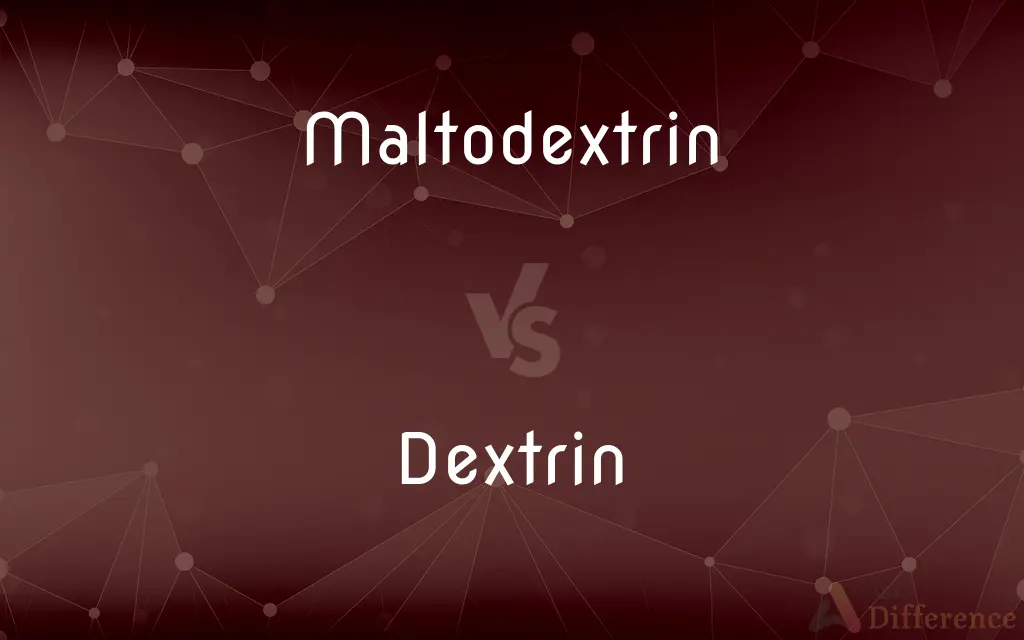Maltodextrin vs. Dextrin — What's the Difference?
By Tayyaba Rehman — Updated on October 25, 2023
Maltodextrin is a carbohydrate derived primarily from starch, used as a food additive, while dextrin is a group of low-molecular-weight carbohydrates produced by the hydrolysis of starch.

Difference Between Maltodextrin and Dextrin
Table of Contents
ADVERTISEMENT
Key Differences
Maltodextrin and Dextrin are both carbohydrates that originate from the hydrolysis of starch. Maltodextrin, a polysaccharide, is often utilized in the food industry as a thickener or filler to increase the volume of processed foods. Its easily digestible nature makes maltodextrin a common choice for energy drinks and supplements.
Dextrin, on the other hand, represents a group of low-molecular-weight carbohydrates. While it also emerges from starch breakdown, the hydrolysis process for dextrin is slightly different, leading to smaller and simpler molecules. Dextrin's properties make it a valuable adhesive in various applications, such as in envelopes or labels.
The primary distinction between maltodextrin and dextrin hinges on their structure and specific uses. Maltodextrin, with its larger molecular composition, serves as a filler in many consumables, enhancing texture and palatability. Dextrin's smaller structure, conversely, offers adhesive qualities useful in multiple industries.
Both maltodextrin and dextrin play pivotal roles in their respective domains. However, it is essential to recognize that while maltodextrin is more closely associated with food products, dextrin finds broader applications outside the realm of consumables, especially in areas demanding adhesive properties.
In the larger picture, both maltodextrin and dextrin highlight the versatility of starch derivatives. Through varied processes, starch can be transformed into distinct compounds, each possessing unique characteristics and functionalities that cater to diverse industry needs.
ADVERTISEMENT
Comparison Chart
Origin
Derived primarily from starch.
Produced by the hydrolysis of starch.
Molecular Weight
Higher molecular weight.
Lower molecular weight.
Primary Use
Food additive (e.g., thickener, filler).
Adhesive in various applications.
Digestibility
Easily digestible.
Less easily digestible compared to maltodextrin.
Solubility
Highly soluble in water.
Varies; generally less soluble than maltodextrin.
Compare with Definitions
Maltodextrin
Commonly used as a food additive.
Maltodextrin enhances the texture of the ice cream.
Dextrin
Varies in solubility based on its type.
This type of dextrin doesn't dissolve as easily in water.
Maltodextrin
Often found in energy drinks and supplements.
Athletes consume maltodextrin for quick energy during workouts.
Dextrin
A group of low-molecular-weight carbohydrates.
The adhesive on this envelope likely contains dextrin.
Maltodextrin
Highly soluble in water.
Maltodextrin dissolves quickly in my morning smoothie.
Dextrin
Results from starch hydrolysis.
Dextrin production involves breaking down starch molecules.
Maltodextrin
A carbohydrate produced from starch.
The protein shake contains maltodextrin for added energy.
Dextrin
Often used in adhesive applications.
The label's stickiness is due to the dextrin-based adhesive.
Maltodextrin
Can serve as a sugar substitute.
The sugar-free candy uses maltodextrin as a sweetener.
Dextrin
Can be used as a crispness enhancer in food.
Dextrin gives these snacks their delightful crunch.
Maltodextrin
Maltodextrin is a polysaccharide that is used as a food additive. It is produced from vegetable starch by partial hydrolysis and is usually found as a white hygroscopic spray-dried powder.
Dextrin
Dextrins are a group of low-molecular-weight carbohydrates produced by the hydrolysis of starch or glycogen. Dextrins are mixtures of polymers of D-glucose units linked by α-(1→4) or α-(1→6) glycosidic bonds.
Maltodextrin
(carbohydrate) A type of dextrin commonly used as a food additive
Dextrin
A soluble gummy substance obtained by hydrolysis of starch, used as a thickening agent and in adhesives and dietary supplements.
Dextrin
Any of various soluble polysaccharides obtained from starch by the application of heat or acids and used mainly as adhesives and thickening agents.
Dextrin
(carbohydrate) Any of a range of oligomers of glucose, intermediate in complexity between maltose and starch, produced by the enzymatic hydrolysis of starch; used commercially as adhesives.
Dextrin
A translucent, gummy, amorphous substance, nearly tasteless and odorless, used as a substitute for gum, for sizing, etc., and obtained from starch by the action of heat, acids, or diastase. It is of somewhat variable composition, containing several carbohydrates which change easily to their respective varieties of sugar. It is so named from its rotating the plane of polarization to the right; - called also British gum, Alsace gum, gommelin, leiocome, etc. See Achroödextrin, and Erythrodextrin.
Common Curiosities
What makes dextrin suitable for adhesives?
Dextrin's properties, resulting from its simpler molecular structure, give it adhesive qualities.
Is maltodextrin typically found in food products?
Yes, maltodextrin is commonly used as a food additive, especially as a thickener or filler.
What is maltodextrin derived from?
Maltodextrin is derived primarily from starch.
Can dextrin be used in food?
Yes, dextrin can be used in food, often as a crispness enhancer.
Is maltodextrin easily digestible?
Yes, maltodextrin is easily digestible, making it popular in energy drinks and supplements.
Are there different types of dextrin?
Yes, there are various types of dextrin, including yellow dextrin and white dextrin, each with distinct properties.
Are both maltodextrin and dextrin carbohydrates?
Yes, both maltodextrin and dextrin are carbohydrates derived from starch.
What's the primary use of maltodextrin in the food industry?
In the food industry, maltodextrin is mainly used as a thickener, filler, or sugar substitute.
Why is dextrin's molecular weight lower than maltodextrin's?
Dextrin results from a different hydrolysis process than maltodextrin, leading to smaller, simpler molecules.
Can maltodextrin serve as a sweetener?
Yes, maltodextrin can act as a sugar substitute, providing sweetness without the same caloric content as sugar.
How does dextrin differ in molecular weight from maltodextrin?
Dextrin has a lower molecular weight compared to maltodextrin.
Is dextrin sticky?
Yes, dextrin possesses adhesive properties, making it sticky and suitable for applications like envelope seals.
Which one is more soluble in water: maltodextrin or dextrin?
Maltodextrin is highly soluble in water, while dextrin's solubility varies based on its type.
Which one, maltodextrin or dextrin, is more commonly found in energy supplements?
Maltodextrin is more commonly found in energy supplements due to its easy digestibility.
Are maltodextrin and dextrin both derived from natural sources?
Yes, both maltodextrin and dextrin are derived from starch, a natural polysaccharide.
Share Your Discovery

Previous Comparison
Bugatti vs. Ferrari
Next Comparison
Gearbox vs. TransmissionAuthor Spotlight
Written by
Tayyaba RehmanTayyaba Rehman is a distinguished writer, currently serving as a primary contributor to askdifference.com. As a researcher in semantics and etymology, Tayyaba's passion for the complexity of languages and their distinctions has found a perfect home on the platform. Tayyaba delves into the intricacies of language, distinguishing between commonly confused words and phrases, thereby providing clarity for readers worldwide.














































